|
Mast: Awlgrip (Page 2)
This page was last updated on 24 April 2005. |
|
<-Return to Page 1
and Dismal Failure Mast Paint,
V. 3.0
After two frustrating attempts to paint the
mast successfully last October, I ended up shelving the project for the
winter. With cold weather and other time limitations, there was no
way I could have succeeded at that time.
[Revisit last fall's
project.]
To ease the pain of the frost-related mast
paint damage, at the time I tried to wet sand the mottled paint, hoping to
buff out the damage. It didn't work, but at least it removed the
roughness and prepared the mast for later steps. If I had had to, I
could have used the mast in that condition; it looked fine from a short
distance, but lacked the depth and gloss of properly-applied Awlgrip. |
With too much going on inside the shop, not to mention a lack of space, I
couldn't hope to get the mast inside in a timely manner. Therefore,
I moved the spar over to the side of the shop, where it spent the winter
buried deeply in snow. Never was it far from my mind, however...one
could say it hung over my head the entire winter. |
Never one to give up without a fight, I determined to try again in the
spring. It took forever for the snow to melt, but finally the piles
shrank enough to allow me to move the mast out of purgatory and over to a
location where I could work on it. Now, all I had to do was wait for
the appropriate weather, or an opening inside the shop (ideally). |
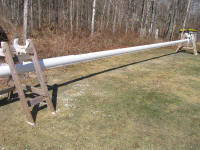 It
soon became clear that, once more, getting the mast into the shop simply
wasn't a viable option, given all the circumstances at hand.
Therefore, I decided that I would have to risk painting it outdoors yet
again. Still, with some warm spring weather on tap, and fairly long
days (much longer than October), I thought I had a fighting chance.
My weather window finally arrived a few weeks into April; Sunday the 17th
was forecast to be into the 70s, dry, sunny, and calm, with overnight lows
expected to remain around 40. It sounded like my best chance, so a
few days before I made final preparations to the mast: taping,
hanging it from two horses, and preparing the paint equipment. It
soon became clear that, once more, getting the mast into the shop simply
wasn't a viable option, given all the circumstances at hand.
Therefore, I decided that I would have to risk painting it outdoors yet
again. Still, with some warm spring weather on tap, and fairly long
days (much longer than October), I thought I had a fighting chance.
My weather window finally arrived a few weeks into April; Sunday the 17th
was forecast to be into the 70s, dry, sunny, and calm, with overnight lows
expected to remain around 40. It sounded like my best chance, so a
few days before I made final preparations to the mast: taping,
hanging it from two horses, and preparing the paint equipment. |
I was ready to paint early Sunday morning, but at 0600 there was still
frost on the mast from the surprisingly cold night. I hoped this
wasn't a harbinger of doom, but I waited, and by a little before 0800 the
sun was already strong, and the frost was gone. It was now or never,
so I mixed up some snow white Awlgrip and prepared to paint. This
time, I chose the standard reducer: my HVLP turbine equipment tends
to force the reducer out of the paint more quickly, often leading to
orange peel if care is not taken, so I had taken to using a slow reducer
to allow the paint more time to level once it was on teh surface.
However, the slow reducer was...well, slow, so it lengthened the tack-free
cure time. I hoped the faster reducer would help me succeed; I
simply needed to stack the deck in my favor wherever possible. |
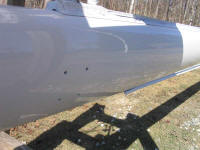 By
0900, I had applied two coats: the first coat was a sort of mist
coat, quite light; the second coat, assisted by the tackiness of the first
coat, was heavier and covered completely. With already 6 coats of
Awlgrip on the mast from October's attempt, 2 coats was ample to cover
completely. With the sun setting after 1900, I thought I had a good
chance to make this job a success. By
0900, I had applied two coats: the first coat was a sort of mist
coat, quite light; the second coat, assisted by the tackiness of the first
coat, was heavier and covered completely. With already 6 coats of
Awlgrip on the mast from October's attempt, 2 coats was ample to cover
completely. With the sun setting after 1900, I thought I had a good
chance to make this job a success. |
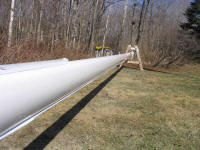 The
next morning, I approached the mast with much trepidation. It had
stayed above freezing all night, and from the house it looked like little
or no dew had fallen; I could see some shine on the mast in the rising
sun, but didn't dare hope just yet. Fortunately, the mast looked
great, and had suffered no overnight damage. Phew. I was
thrilled that this project had finally come to completion. The end
result looked very good, with good shine and depth and little or no orange
peel. I found a run or two high up on the mast, but these would
never be noticeable when the mast was stepped. The
next morning, I approached the mast with much trepidation. It had
stayed above freezing all night, and from the house it looked like little
or no dew had fallen; I could see some shine on the mast in the rising
sun, but didn't dare hope just yet. Fortunately, the mast looked
great, and had suffered no overnight damage. Phew. I was
thrilled that this project had finally come to completion. The end
result looked very good, with good shine and depth and little or no orange
peel. I found a run or two high up on the mast, but these would
never be noticeable when the mast was stepped. |
A few days later, I attended to the spreaders, jumper struts, and spreader
bases. Rather than try and bother with the Awlgrip system on these
small parts, I instead elected to use basic spray paints in cans. |
I began by cleaning and lightly sanding the pieces. Frankly, I
didn't worry too much about it, because these parts would be easy to
repaint down the road as needed, since I unstep the mast each year.
Once the parts were clean and prepped, I hung them from an old ladder with
some small twine, choosing an inconspicuous place to attach the hanger.
The inner ends of the tubes, where the spreaders and jumpers insert into
their bases, was ideal for this. |
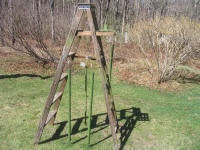 Next, I sprayed the aluminum with zinc chromate primer, which is generally
similar to the yellow chromate primer used in the Awlgrip system. I
applied a couple coats in order to get complete coverage. It was
rather breezy outdoors, so I positioned my spraying station where the
overspray wouldn't get on anything important (like my nearby mast). Next, I sprayed the aluminum with zinc chromate primer, which is generally
similar to the yellow chromate primer used in the Awlgrip system. I
applied a couple coats in order to get complete coverage. It was
rather breezy outdoors, so I positioned my spraying station where the
overspray wouldn't get on anything important (like my nearby mast). |
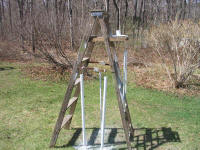 After allowing the primer to cure for a couple hours, I continued with
some gloss white topcoat, and spray-applied several coats until the parts
looked completely covered. After allowing the primer to cure for a couple hours, I continued with
some gloss white topcoat, and spray-applied several coats until the parts
looked completely covered.Next:
reinstalling hardware and accessories.
Click here to
continue. |
|